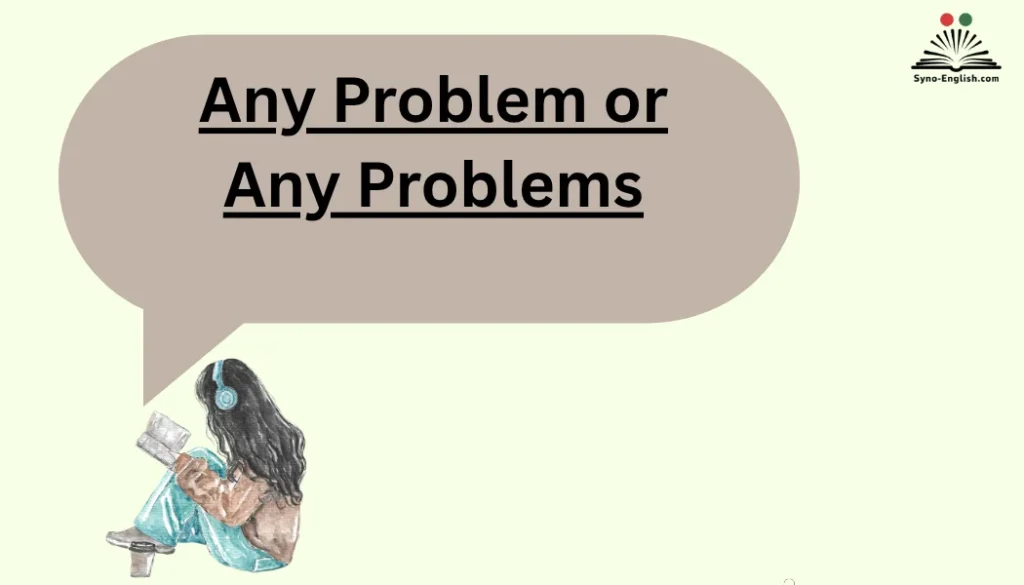In English, small details can feel like tricky puzzles that even advanced learners find challenging to solve. When discussing Any Problem or Any Problems, this subtle difference carries weight — it shapes tone, formality, and meaning, affecting how natural your sentence sounds in real conversation.
From my own learning journey, I’ve found that such nuances often depend on the speaker’s sense of what fits best in context.In my experience, phrases like these depend heavily on grammar, choice, and context. The singular form (any problem) highlights a common or single issue,
while the plural form (any problems) opens possibilities for several. Which to use should rely on how formal or casual your tone needs to be, and whether you want to sound polite or conversational. It’s less about correctness and more about the flow and intent of your expression.
Why This Question Matters
Have you ever noticed how one word can change the feel of a sentence? Imagine a support agent asking:
- “Do you have any problem with your account?”
- “Do you have any problems with your account?”
Both are grammatically correct, but the second one feels more natural in conversation. The first sounds more formal or even slightly distant.
This isn’t just a matter of preference. Understanding the difference helps you:
- Write professional emails without sounding too stiff.
- Speak naturally in conversations.
- Avoid mistakes in academic or business contexts.
- Communicate with clarity when English isn’t your first language.
The debate matters because English doesn’t always follow simple logic. Singular and plural forms change meaning in subtle ways.
The Core Grammar of “Any”
To decide whether you need singular or plural, you first have to understand how “any” works in English grammar.
What “Any” Means
“Any” is a determiner. That means it sits before a noun to show quantity or extent. Unlike “a” or “the,” it usually implies no limit or no specific choice.
Examples:
- You can take any book from the shelf.
- I don’t have any time left.
- Do you know any doctors in this city?
Notice how “any” works with singular count nouns (book), plural count nouns (doctors), and uncountable nouns (time).
How “Any” Functions with Nouns
- With singular countable nouns, “any” highlights one unspecified item.
- If you have any question, raise your hand.
- With plural countable nouns, it shows multiple possibilities.
- If you have any questions, feel free to ask.
- With uncountable nouns, it refers to an undefined quantity.
- Do you have any information about the case?
This flexibility is why English learners often struggle. The same determiner shifts meaning depending on the noun that follows.
Singular Form: “Any Problem”
So when is any problem the correct choice?
Situations Where Singular Is Correct
You use the singular when referring to one unspecified issue rather than multiple. It often appears in formal writing or in contexts where the speaker wants precision.
Examples:
- Please contact HR if you face any problem with your paycheck.
- Do you see any problem with the logic in this proof?
- The lawyer explained that there isn’t any problem with the contract.
The Tone of “Any Problem”
The singular form feels formal, precise, and sometimes technical. It often shows up in written English—business communication, contracts, manuals, and legal contexts.
For example, in technical documentation you might read:
If you encounter any problem installing the software, refer to the troubleshooting section.
Here, singular emphasizes one potential issue at a time rather than multiple.
Plural Form: “Any Problems”
Now let’s shift to any problems—the version you’ll hear more often in everyday life.
Situations Where Plural Feels Natural
The plural form works best when you’re asking about multiple possible issues. It sounds casual, open-ended, and conversational.
Examples:
- Are you having any problems with your new phone?
- Let me know if you run into any problems on the road.
- We didn’t experience any problems during the trip.
Everyday Conversational Use
Customer service, casual workplace chat, and friendly check-ins almost always use any problems. It’s less rigid and more people-friendly.
In fact, you’re more likely to hear:
Any problems with your order today?
than
Any problem with your order today?
Comparing the Two: Nuance and Tone
Both versions are grammatically correct. The difference lies in tone and context.
| Expression | Tone | Common Use | Example |
| Any problem | Formal, precise, technical | Contracts, instructions, legal text | If there is any problem, notify the supervisor. |
| Any problems | Casual, conversational, reassuring | Customer service, everyday talk | Any problems with your new laptop? |
Regional Tendencies
- American English tends to use plural more often in casual speech.
- British English also favors the plural in everyday conversation, though formal writing still leans toward the singular.
Subtle Meaning Differences
- Any problem = looking for a single issue.
- Any problems = open to multiple possible issues.
That subtlety explains why “any problems” feels friendlier—it doesn’t limit the listener to one concern.
Real-World Examples and Contexts
Language comes alive in real situations. Here’s where you’ll see each form.
Workplace Scenarios
- Customer Support: If you face any problem logging in, reset your password.
- Team Communication: Let me know if you have any problems with the new process.
Everyday Conversations
- Asking a friend: Any problems with your car lately?
- Offering help: If you have any problem, just give me a call.
Written English
- Manuals: In case of any problem, contact your supplier.
- Emails: Please inform me if there are any problems with the attached file.
Media Usage
In TV shows or movies, characters almost always say:
- Any problems?
That quick plural fits the rhythm of everyday speech.
What Data Shows: “Any Problem” vs “Any Problems”
Grammar is one thing, usage is another. Let’s look at real data.
Google Ngram Viewer
A search of Google Ngram reveals that any problems has become far more common since the mid-20th century. The plural dominates in modern books and published material.
Corpora Insights
- Corpus of Contemporary American English (COCA): “Any problems” outnumbers “any problem” in spoken contexts.
- British National Corpus (BNC): Similar trend in British English. Plural dominates in conversations, while singular shows up in technical writing.
In short: modern English overwhelmingly favors any problems in daily use, while any problem survives in formal and technical text.
Common Mistakes and How to Avoid Them
Many English learners (and even native speakers) mix up the two forms. Here’s how to avoid slip-ups.
Overusing Plural in Formal Writing
- ❌ The contract does not present any problems with liability.
- ✅ The contract does not present any problem with liability.
Using Singular in Casual Speech
- ❌ Did you have any problem finding the office? (Sounds stiff in conversation.)
- ✅ Did you have any problems finding the office?
Confusing Countable vs. Uncountable
Remember: problem is countable. But some nouns aren’t. For example:
- ✅ Do you have any advice? (Uncountable → never pluralized.)
- ✅ Do you have any problems? (Countable → pluralized when multiple possible.)
Quick Reference Table
Here’s a handy chart you can save or print:
| Context | Correct Usage | Example |
| Formal writing (contracts, manuals) | Any problem | If there is any problem with delivery, contact support. |
| Casual conversation | Any problems | Any problems with your new phone? |
| Technical instructions | Any problem | If you notice any problem, restart the system. |
| Friendly workplace check-in | Any problems | Let me know if you run into any problems. |
Conclusion
The distinction between Any Problem or Any Problems may seem like a tiny detail in the vast English language, but it represents how deeply grammar, tone, and formality interact in communication. Through my own learning journey, I’ve realized that even such subtle nuances carry power — they shape how confident, polite, or natural a person sounds. Using any problem works best when addressing a single issue or emphasizing formality, such as in professional contexts. On the other hand, any problems flows more naturally in everyday conversation, inviting openness and friendliness. Understanding these layers helps learners communicate with greater clarity and confidence, reducing hesitation and second-guessing while improving overall fluency.
Ultimately, mastering the choice between these two phrases is about awareness, not strict rules. It requires active listening, careful use, and the courage to trust your ear. Once you develop this intuitive sense, the difference feels less like a puzzle and more like a skill — a reflection of how flexible and expressive English can be. Whether you’re writing an email, chatting casually, or giving a presentation, choosing the right form helps you strike the perfect tone. The goal is simple: to communicate meaningfully without stumbling over words. With consistent practice, learners not only grasp grammar but also gain an authentic voice that fits better in every context.
FAQs
What is the main difference between “any problem” and “any problems”?
“Any problem” refers to one issue; “any problems” suggests several.
Is one more formal than the other?
Yes, “any problem” sounds slightly more formal.
Can both be used in writing?
Yes, depending on tone and context.
Which is used in casual speech?
“Any problems” fits casual conversations.
How can learners remember the usage?
Think of singular for one, plural for many.
Does tone change meaning?
Yes, tone can make one sound more polite or neutral.
Are they interchangeable in all situations?
Not always; meaning may shift slightly.
Which is preferred in emails?
Formal emails often use “any problem.”
How can I practice using them correctly?
Listen to native speakers and note patterns.
Why does this difference matter?
It improves fluency and ensures natural communication.

Emma Brooke is a passionate English educator, writer, and language enthusiast with over a decade of experience helping learners master the nuances of the English language. At SynoEnglish, she blends practical grammar advice with real-world communication tips to make English easier, clearer, and more enjoyable for readers of all levels.



